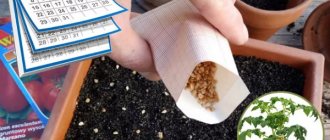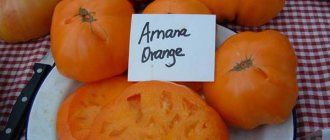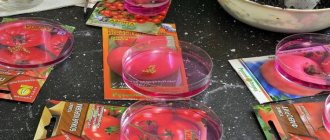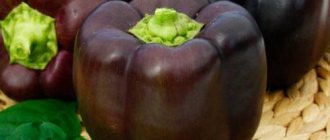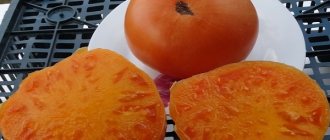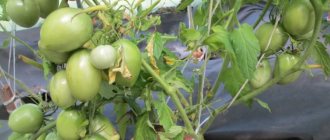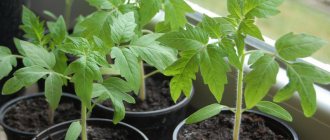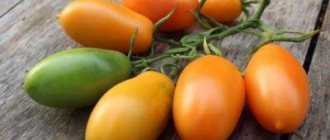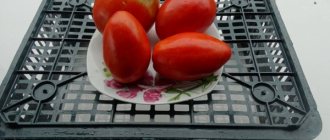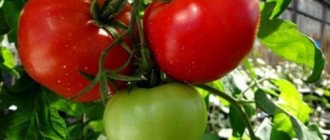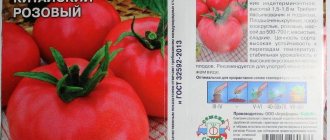The Altai orange tomato variety, bred by Russian breeders, is excellent for dietary and baby food, as well as for making juices and purees. The ease of caring for the tomato and its basic characteristics make its cultivation convenient for novice gardeners.
| Height | Landing location | Ripening time | Fruit color | Fruit size | Origin | Fruit shape |
| Tall | Greenhouse, Open ground | Mid-season | Orange | Large | Variety | Flat-round |
Description of the variety
The Altai orange tomato is an indeterminate, mid-season, large-fruited variety that can be grown in the southern regions, the middle zone and Altai.
The plant reaches a height of 1.4-1.7 m . It is formed by pinching the tops of the shoots, otherwise the crop will consume nutrients only for growth. Formation into 1 stem promotes faster ripening of fruits.
The height of the plant indicates the need for garter . The tomato foliage is large and dark emerald in color. There are 5 inflorescences in a brush. The lower racemes grow after the second permanent leaves, each subsequent one appears after two leaves.
From the moment the first shoots appear until the fruit ripens, about 3.5 months pass . The largest fruits ripen on the lower clusters, their weight reaches 450 g. In the upper part of the plant, the weight of the fruit is no more than 250 g, when formed into 1 stem - up to 650 g.
Productivity is high . One bush produces up to 4.5 kg of vegetables, and from 1 sq. m harvest 10-12 kg.
The fruits are fleshy and contain amino acids, lycopene, and beta-carotene in the pulp, which help improve immunity. The taste is sweet, there are 3-6 seed chambers. The color of a ripe tomato is orange or, as gardeners say, orange. When ripe, the fruits do not crack. Excellent transport over long distances.
Other varieties of tomatoes:
Bright early tomato with large fruits - the “King of the Market” tomato
Large and easy-to-care tomato “Family f1”
Time-tested and beloved by many summer residents, the Dubrava tomato
The series of this species includes subspecies: Altai red and pink .
The main difference between them is, of course, the color of ripe vegetables. The taste and other qualities are almost the same. Reviews of the Altai red tomato indicate the popularity of the crop among gardeners . Everyone involved in its cultivation notes that regular watering, periodic fertilizing and timely loosening are enough to obtain a stable harvest. The effectiveness of using drip irrigation is also highlighted.
Characteristics and description of the Altai pink tomato variety includes additions in the form of resistance to cold and later ripening of fruits compared to its “brothers”. Experts and amateurs exchange opinions and report that with proper care, the results meet expectations.
The photo (above) shows the rich colors of the Altai pink and orange fruits.
ALTAI PINK TOMATO. Video review by Olga Chernova.
Features of cultivation
Seeds for seedlings are sown in any ten days of March. Planted under film in late May-early June. Harvesting occurs from late July to mid-September.
Garter
Already on the second or third day after planting the seedlings in open ground, the stem is tied to a trellis wire. The twine is secured under the first or second leaf, making sure that as the stem grows and thickens, the rope does not cut into the fabric.
Formation
Plants grow in one stem, cutting off all the stepsons and leaving a small stump in place of each. The lower leaves that have served their purpose must be removed. The signal to begin the operation is the yellowing of the leaf plates. No more than two leaves are removed at each time. The stem is exposed only up to 5-6 brushes. At the end of August, the top of the main stem is pinched, allowing all the fruits to ripen.
How to grow seedlings
Before sowing seeds, they must be disinfected in a solution of potassium permanganate, washed with clean water and dried . Treatment with a growth stimulator will significantly increase their germination. The soil for seedlings consists of soil mixed with humus or peat. You can also add a small portion of superphosphate and wood ash here.
After making small depressions in the soil, begin sowing the seeds . The container is suitable both general (wooden boxes) and individual (peat pots, plastic glasses).
Reference. It is more convenient to sow seeds in individual containers. This method allows you to avoid subsequent picking.
After sowing, the seeds are covered with peat and sprayed with warm water . The containers are covered with film. In the room where the seedlings are located, the permissible air temperature is at least 25°C.
When the first shoots appear, the film is removed . It is important not to allow the soil to dry out; it must be kept moist.
If the seeds were sown in a common wooden box , then the sprouted seedlings need picking. They dive after the formation of two full-fledged leaves, after which the sprouts are planted in separate containers.
When the seedlings reach 50 days, they are ready to continue further development in a greenhouse or open ground.
This tomato can be grown by sowing seeds directly into the soil . But this method is only possible in the southern regions. This approach has a significant drawback: the chance of rejecting weak seedlings is reduced. Growing tomatoes through seedlings is a more effective method and leads to high qualitative and quantitative indicators.
Bush care
How to care:
- Watering tomatoes is necessary as soon as the top layer of soil begins to dry out. For irrigation, use warm, settled water;
- In between waterings, the soil needs to be loosened to prevent the formation of a hard crust, which will limit the access of oxygen;
- Over the entire season, they are fed 3-4 times with complete complex or organic fertilizers (diluted mullein or bird droppings). It is permissible to carry out root and foliar fertilizing (spray with superphosphate diluted in water);
- An important point is the formation of bushes. Tomatoes are grown in 1-2 stems, removing the stepsons above the third cluster. If the stem is too elongated, the growing point needs to be pinched. To improve air exchange and provide access to sunlight to the fruits, you need to remove the lower leaves on the bushes. Most gardeners pinch off small or deformed flowers on the racemes to obtain larger fruits.
To plant seedlings in the ground, it is necessary that the seeds are sown in early March and that the seedlings are 60-65 days old for full survival in open ground and successful fruiting.
Tomato seeds are sown in one deep tray or seedling cassettes. You can buy ready-made soil for sowing, or you can prepare it yourself:
- humus – 1 part;
- turf soil - 1 part;
- lowland peat – 1 part.
Mix everything well. Fertilizers are added to 10 liters of soil mixture:
- urea;
- superphosphate;
- potassium sulfate.
Sow the seeds one at a time into the cells of seedling cassettes or general containers at a distance of 3-5 cm, deepening by 0.5-1 cm. The seeds germinate 5-7 days after sowing. The seedlings are picked after the second leaf appears on them, transplanting them into separate molds for each, or to save money, you can plant them in a larger common box. In order for the seedlings to better tolerate transplantation into the greenhouse, it is still recommended to plant them in separate containers (cups, boxes).
If sown in separate cells of seedling cassettes, transfer the grown seedlings into separate cups, deepening the trunk to the cotyledon leaves. This trick allows you to stimulate the growth of lateral roots on the trunk and gain two whole weeks before the start of flowering and fruiting, since the seedlings do not waste energy on rooting after transplantation.
Altai orange tomato in a greenhouse photo
The seedlings take root in about 10-14 days and then watering should begin. In open ground, watering tomatoes depends on the weather conditions of the region. In the absence of rain, watering is carried out once every 5 days, and in the greenhouse once every 3 days, since the soil dries out faster there.
To get larger fruits, it is necessary for the tomato to grow in one stem, and to increase the number of tomatoes, a plant is formed into two or three stems. Stepchildren need to be pinched to prevent them from stretching above 5 cm.
Every week it is necessary to plant the stepson so that the bushes form normally. As soon as tomatoes appear at the bottom of the plant, it is imperative to begin removing the lower leaves. This process helps to improve the moisture content in the roots of the plant and focus energy on the development of tomatoes, as well as increase the lighting of the bush.
When there is good air circulation between the plant bushes, they are less susceptible to disease and the fruiting of tomatoes increases. Like any plant, the Altai orange tomato also needs fertilizers and various feedings, which must be done at least 3 times per season.
When the ovary is forming, you can use the “Ovary” fertilizer to stimulate flowering.
How to grow tomatoes
Tomatoes are planted in holes at a distance of 50 cm from each other with a row spacing of 80 cm . Place one tablespoon of superphosphate mixed with potassium salts in each well. A sunny area, protected from drafts, is well suited as a permanent location. Tomatoes are planted in open ground at a stable air temperature of +15°C.
Reference. Areas where carrots, cabbage, and legumes previously grew are well suited for growing tomatoes.
Water the crop with warm, settled water as the soil dries . In greenhouses this is done in the morning, in the garden - in the evening. Underwatering and overwatering are equally harmful to the plant. Excess moisture causes roots to rot, and if there is a lack of moisture, vegetables do not form well.
Reference. Cold water has a detrimental effect on this tomato crop: the development of its root system stops.
After watering, the soil is loosened and weeds with roots are removed..
They do not feed often, 3-4 times throughout the season . Complete complex fertilizers or organic matter are applied. Bird droppings or mullein infusion are used as organic matter. The tomato responds well to both root and foliar feeding, for example, spraying with superphosphate diluted in water.
Reference. If there is insufficient fertilizing, fruiting deteriorates.
Bushes are pruned before the end of the growing season . By removing the stepsons above the third cluster, you end up with 1-2 stems. On tall plants, pinch the crown to prevent further growth. If you remove small or deformed flowers, future fruits will be larger.
Of course, a plant height of 1.7 m requires a garter . To do this, install wooden stakes or metal rods next to each bush. Since the fruits grow to be quite heavy, tying the clusters is also possible, otherwise the stems will begin to break from their own weight.
Diseases and pests
Diseases affecting the nightshade family are rare .
The species is resistant to fusarium and tobacco mosaic. However, prevention in the form of spraying with a solution of potassium permanganate will not be superfluous. Preparations containing copper provide protection against late blight . Tomatoes often suffer from fungal diseases such as root and blossom end rot. To prevent them from entering your garden, it is enough to periodically loosen the soil and remove weeds. It is also useful to spray the plant with non-toxic biological products, for example, Fitosporin.
When flowering, young bushes are attacked by whiteflies and spider mites . Spraying with a weak solution of potassium permanganate will help here.
The Colorado potato beetle, slugs, and mole crickets pose a serious threat to vegetable crops . Mulching the beds with straw and fragrant herbs growing next to the tomatoes - marigolds and calendula - helps against mole crickets. They scare away the mole cricket with a pungent odor. Decoctions of celandine and onion peels help protect against other pests from the insect world.
But the most productive method in the fight against insects is regular inspection of the tomato crop for the presence of pests . Slugs and Colorado potato beetles are collected by hand, and the stems are sprayed with an aqueous solution of ammonia.
Rules for planting and care
The description of the variety states that the Altai orange tomato is propagated by seedlings. Seeds are sown in March from the 1st to the 20th. By the time of transplanting into the ground, the seedlings should be fully formed. The age of high-quality seedlings is 60 days, maximum 65.
How to grow seedlings
Sowing of seeds is carried out in a common container. Take plastic containers 15-20 cm high. Prepare the soil mixture:
- humus – 1 part;
- turf soil - 1 part;
- lowland peat – 1 part.
Mix everything well. Fertilizers are added to 10 liters of soil mixture:
1 tsp each.
Shoots at a temperature of 22-25 °C appear in 5-7 days. After the appearance of the 2nd true leaf, the seedlings dive. Transplant them into separate glasses (milk bags or cartons). You can dive into a larger common box. In a separate container, the roots develop better, and the seedlings do not get sick when transplanted into the ground.
Transplanting seedlings
Seedlings of the Altai Orange variety can be transplanted into the greenhouse in April or early May. The soil should warm up to 15 °C. In cold soil, tomato seedlings stop growing and may die. Ground temperature is considered critical if it is less than 10 °C.
Altai orange tomato is planted in open ground according to the time limits accepted in the region. They depend on weather conditions. Usually transplantation is carried out from June 1 to June 10. The holes are formed according to a 50 x 40 cm pattern. 3-4 Altai orange tomato seedlings are planted per 1 m².
Humus (8-10 kg/m²), superphosphate (25 g/m²), potassium sulfate (15-20 g), urea (15-20 g) are added to the soil. They immediately put up stakes. Seedlings are transplanted using the transshipment method. Overgrown seedlings are planted at an angle. They are tied to stakes immediately or after 5-10 days.
Tomato care
Watering the bushes begins 10-14 days after transplanting the seedlings into the ground. By this time she is getting used to it. The roots begin to work. In a greenhouse, tomatoes are watered more often (once every 3 days), where the soil dries out faster. In the garden, the Altai orange tomato is watered according to the weather. If there is no rain, then once every 5 days.
Stepchildren are pinched as they appear. Do not allow them to stretch more than 5 cm. To obtain large tomatoes, grow the tomato into one stem. If the goal is to grow more fruits, then choose a formation scheme of two, less often 3, stems.
Stepping is carried out weekly. This allows you to maintain the bushes in good condition. After the fruits form in the lower clusters, the lower leaves begin to be removed. This procedure is mandatory. It pursues 3 goals:
- Improve the lighting of the bush.
- Direct the plant’s forces to form fruits.
- Normalize the humidity level in the root zone.
Tomatoes love it when air circulates freely between the bushes. The fruit sets better. Tomatoes are less likely to suffer from fungal diseases. The Altai orange tomato responds well to root and foliar feeding. During the season they need to be carried out at least 3 times:
- the first, when the buds are formed in the first cluster, are fertilized with mullein infusion;
- the second, when the ovaries are formed in the second brush, use nitroammophosphate, superphosphate, and ash;
- the third, during active fruiting, is fed with potassium monophosphate to accelerate ripening.
During the period when the ovaries are forming, Altai orange tomato bushes are fed with complex preparations for tomatoes: “Tomaton”, “Ovary”, “Sudarushka”. They contain microelements. Root feeding is carried out after watering. Spraying the leaves with liquid fertilizers is done in the morning or evening.
The nuances of growing in open ground and greenhouses
You can plant seeds in open ground only in the southern regions . This is due to the fact that the growth and development of vegetable crops depends on temperature conditions. Despite the fact that the variety is resistant to cold, such weather conditions negatively affect the development and formation of fruits.
The fact is that the Altai variety of tomatoes can withstand cold only for a short time , so to speak, changes in weather conditions. Prolonged cold spells are detrimental to it. Therefore, in the middle zone, initial cultivation in greenhouse conditions is recommended. Next, when the weather is warm, the tomatoes are planted in the garden.
Since the crop tends to grow in height, do not forget about the obligatory pinching of the top, otherwise the beneficial substances will go into the growth of the plant, and not into the fruits that set.
A timely installed support for a garter helps maintain the integrity of tall bushes .
Pros and cons of the Altai orange tomato variety
There are no obvious shortcomings due to which it is worth refusing to grow Altai Orange tomatoes. Gardeners note that crop yield depends on soil fertility and fertilizing, so this should not be neglected.
Among the positive aspects it is worth noting:
- excellent taste of fruits;
- large size;
- good yield;
- easy care;
- endurance;
- high immunity to various diseases.
In addition, the tomato variety is quite transportable and can be transported over long distances. At the same time, the safety of the fruit is high.
Harvesting and application
The collection of ripe vegetables begins in mid-summer and continues until the first frost . They can be used both at home and on an industrial scale. Tomatoes that are not yet fully ripe can turn red on their own.
Vegetables are especially good fresh - in salads they will delight any gourmet not only with taste, but also with color. The preparation of tomato products – juice and ketchup – is also common. Altai Orange is not suitable for preparations in jars due to its large size.
But it is well suited for commercial purposes , as it can be stored for a long time in a cool place. This fact allows them to be sold almost all year round.
Vegetables are good for children's and dietary nutrition . Doctors recommend Red Altai tomatoes for allergy sufferers when other types of tomatoes are not suitable. Juices and purees are prepared from tomatoes for children.
Positive and negative qualities of the variety
Experts have summarized the reviews of vegetable growers who grew this variety, and based on the data collected, note the following positive qualities of Altai Orange tomatoes:
- good taste of grown fruits;
- the ability to transport the grown crop over fairly long distances without spoiling the fruit;
- beautiful appearance of ripe tomatoes;
- tomatoes of this variety are not prone to cracking;
- high productivity.
The disadvantages include the extended time of fruit ripening - from mid-summer to the first frost.
Advantages and disadvantages
The tomato crop from Altai combines many positive qualities , which is confirmed by many assessments of those who have planted it for more than one year:
- resistance to major nightshade diseases;
- ability to withstand periodic temperature changes;
- easy care;
- high fruiting rate;
- rich taste of tomatoes;
- excellent transportability;
- large fruits;
- color variety;
- fruiting for a long time;
- Possibility of use for baby and diet food.
Negative properties include:
- mid-ripening;
- obligatory garter;
- mandatory stepsoning;
- dependence of fruit formation on fertilizing.
Productivity and fruit characteristics
The fruits of the Orange Russian 117 variety begin to ripen 111–125 days after the seeds germinate. With the right agricultural technology, you can harvest up to 3 kg from one bush in open holes, and up to 4.5 kg in greenhouses and greenhouses. The fruits of the Orange Russian 117 variety are endowed with many advantages compared to other indeterminate type tomatoes.
Characteristics of the fruit, which can also be attributed to its advantages:
- Weight. The average fruit weight is 300 grams.
- Form. The tomatoes are round, with a pointed tip. Heart shaped.
- Color. The skin of tomatoes is covered with a red tint with orange strokes. The tips of the fruits are deep crimson in color. At the same time, the tomatoes are also of a non-uniform shade from the inside. In the thickness of the orange pulp, red veins are observed.
- Pulp. The inside of Orange Russian tomatoes is dense, with a small number of seeds.
- Taste. The fruits are endowed with good taste, with a predominance of sugar.
- Transportability. Due to their thick skin, tomatoes do not lose their appearance during long-distance transportation.
- Shelf life. For 40 days at a temperature of +2 degrees, the fruits are able to retain their presentation.
According to their intended purpose, tomatoes are used fresh and in preparation: canned whole fruit, sauces, natural juices and tomato pastes.
Tomato variety Russian 117 does not need special care. For its proper development, it will be enough to carry out timely watering, weeding and fertilizing with mineral and nitrogen fertilizers. Also, do not forget about insect pests. Timely prevention will also prevent the formation of infectious diseases.
Farmer reviews
Reviews of the Altai Orange tomato indicate, first of all, excellent taste .
They also note the ease of caring for the crop and its high quantitative indicator. And of course, gardeners welcome the extended fruiting period, which allows them to enjoy fresh fruits for a long time. Alexandra, Yartsevo village : “The tomato attracted attention with its appearance and the possibility of cultivation in open ground.
I want to tell novice vegetable growers that it is better to plant through seedlings. It was transferred to the ground after the end of the spring frost period. I fertilized and watered infrequently. The fruits are very large, juicy, and sweet in taste. Due to the long fruiting period, I used them fresh throughout the season.” Oleg, Biysk : “I’ve been growing orange tomatoes for many years. I usually plant it in 2 stems to get the maximum yield. The vegetables are tasty, sweet with a slight sourness. It’s nice to be able to harvest fresh tomatoes for a long time.”
Varietal characteristics
The yield of tomatoes of this variety depends on the quality of care and place of growth. The yield is higher in the greenhouse. If you follow the planting scheme of 3-4 bushes per 1 m², 10 kg are harvested from the Altai orange tomato variety (3-4 kg from one bush). In the garden, 12-15 tomatoes are formed on one plant. The size depends on the pattern of bush formation, the quality and quantity of fertilizing.
The fruiting period begins early. The first Altai orange variety tomatoes are harvested in early July. When seedlings are planted in a greenhouse in April, the first harvest is enjoyed at the end of June. Fruiting lasts a long time. The last fruits are harvested at the end of August.
Advice! During flowering, the bushes need to be fed with an infusion of ash. The fruits will become even more sugary.
If you follow crop rotation and carry out planned preventive measures, the Altai orange tomato does not get sick. Gardeners note that tomato is resistant to verticillium and fusarium, and rarely suffers from tobacco mosaic virus.
As measures to prevent rot (root, crown) it is recommended to carry out preventive measures:
- keep the soil clean;
- loosen the soil;
- mulch the beds;
- treat the bushes with the drug “Fitosporin-M”.
You can expect an insect invasion during flowering. The Altai Orange tomato variety may be threatened by:
- whitefly;
- thrips;
- spider mite;
- aphid;
- Colorado beetle;
- bear
The beetle and mole cricket are collected and destroyed, the bushes are treated with an aqueous solution of ammonia. Insecticides are used for mites and whiteflies; for aphids, an ash-soap solution and a decoction of celandine are used.
Pros and cons of the variety
Tomato has no obvious disadvantages. There are features on which the yield of the Altai Orange variety depends:
- soil fertility;
- mandatory summer feeding.
The advantages include:
- taste, color, size of fruits;
- stable yield;
- standard, uncomplicated care;
- good adaptation to weather conditions;
- stable immunity of tomatoes of the Altai orange variety.
Taste qualities
The variety is famous for its unusual taste and size of fruits. And this is not surprising! Some specimens reach a weight of 700 g. However, you need to properly form the plant and fully care for it. On average, the weight of a tomato varies from 250 to 300 g.
The fruits are round, flattened, ribbed at the base. The skin is a rich orange color, which indicates the ripeness of the tomato. The pulp is sugary, juicy, sweet. There are few seed chambers, which is clearly visible in the cross-section. The taste of the fruits of the Altai orange variety is excellent. A pronounced fruity note.
How to summon a spirit that grants wishes - the rules of the ritual
A salad variety, but it is suitable for preserving tomato juice. The fruits tolerate transportation well, do not spoil for a long time, and are successfully ripened in storage.
Diseases and pests
Tomato is rarely affected by the main nightshade diseases. Resistant to fusarium, verticillium, tobacco mosaic.
The use of potassium permanganate solutions allows you to avoid such diseases. Copper-containing preparations will provide good protection against late blight.
Weeding and loosening the soil reduces the risk of root rot and prevents fungal diseases.
In open areas there may be a threat from harmful insects. This forces us to inspect the bushes once a week. For preventive purposes, you can spray with a solution of potassium permanganate.
The larvae of Colorado beetles, the beetles themselves, and slugs are collected by hand. To combat aphids, use a warm soapy solution, which is used to treat the leaves. The main thing is to prevent the solution from getting on the soil.
Soil preparation
The soil for tomatoes should be prepared in the fall by adding compost and ash. Tomatoes feel good on lands with a high content of organic matter, potassium, and nitrogen. These plants perform best in slightly alkaline soil. In order for the soil to acquire the desired pH level, ash is added to it. It has an alkaline reaction and contains up to 5% potassium.
Tomato seedlings grow faster if the bed is preheated. In open ground, this is achieved by covering the bed with film or other covering material.
When planting seedlings, do not be afraid to deepen them to the first leaves. This will help build a strong root system.
Agricultural technology
When growing tall indents, which include Altai orange, you need to take into account the slow flowering rate and the extended period of fruit formation.
- The timing of sowing depends on the method of cultivation. Seeds are sown from March 1 to March 20, with the expectation that by the time of transplanting to a permanent location, the seedlings should be well developed, at the age of 60-65 days. Seedlings dive with the appearance of 2 permanent leaves.
- Seedlings are transplanted into greenhouses with solar heating after May 15, and when grown in open ground - after June 5. For 1 sq. 3-4 bushes are placed per meter, according to a 50 x 40 cm pattern. Immediately install supports to which the plants are tied.
- Further care comes down to watering, fertilizing, pruning shoots, protecting tomatoes from pests and diseases. Weeding is combined with mandatory loosening of the soil.
- The plant is led into two trunks, removing all lateral stepsons. The growth point is pinched after 5-6 clusters are formed on the stem.
- To get fruits of maximum size, only one stem is left and the number of ovaries is normalized, the number of which in a cluster should not exceed 3 pieces. Leaves that are too large and have begun to turn yellow are removed.
- Tomatoes are harvested as they ripen, from the first days of July to the end of August.
When growing indents, agrotechnical techniques that limit the growth of vegetative mass are relevant. As a result, the plant has more resources for the formation and ripening of fruits.
